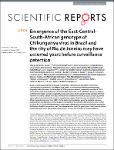Emergence of the East-Central-South-African genotype of Chikungunya virus in Brazil and the city of Rio de Janeiro may have occurred years before surveillance detection
Souza, Thiago Moreno L.
Rangel Vieira, Yasmine
Delatorre, Edson
Barbosa-Lima, Giselle
Luiz, Raul Leal Faria
Vizzoni, Alexandre
Jain, Komal
Mesquita Miranda, Milene
Bhuva, Nishit
Gogarten, Jan F.
Ng, James
Thakkar, Riddhi
Surrage Calheiros, Andrea
Monteiro, Ana Paula Teixeira
Bozza, Fernando A.
Tschoeke, Diogo A.
Leomil, Luciana
de Mendonça, Marcos Cesar Lima
dos Santos Rodrigues, Cintia Damasceno
Torres, Maria C.
Bispo de Filippis, Ana Maria
Ribeiro Nogueira, Rita Maria
Thompson, Fabiano L.
Lemos, Christina
Durovni, Betina
Cerbino-Neto, José
Morel, Carlos M.
Lipkin, W. Ian
Mishra, Nischay
Brazil, which is hyperendemic for dengue virus (DENV), has had recent Zika (ZIKV) and (CHIKV) Chikungunya virus outbreaks. Since March 2016, CHIKV is the arbovirus infection most frequently diagnosed in Rio de Janeiro. In the analysis of 1835 syndromic patients, screened by real time RT-PCR, 56.4% of the cases were attributed to CHIKV, 29.6% to ZIKV, and 14.1% to DENV-4. Sequence analyses of CHIKV from sixteen samples revealed that the East-Central-South-African (ECSA) genotype of CHIKV has been circulating in Brazil since 2013 [95% bayesian credible interval (BCI): 03/2012-10/2013], almost a year before it was detected by arbovirus surveillance program. Brazilian cases are related to Central African Republic sequences from 1980’s. To the best of our knowledge, given the available sequence published here and elsewhere, the ECSA genotype was likely introduced to Rio de Janeiro early on 2014 (02/2014; BCI: 07/2013-08/2014) through a single event, after primary circulation in the Bahia state at the Northestern Brazil in the previous year. The observation that the ECSA genotype of CHIKV was circulating undetected underscores the need for improvements in molecular methods for viral surveillance.

